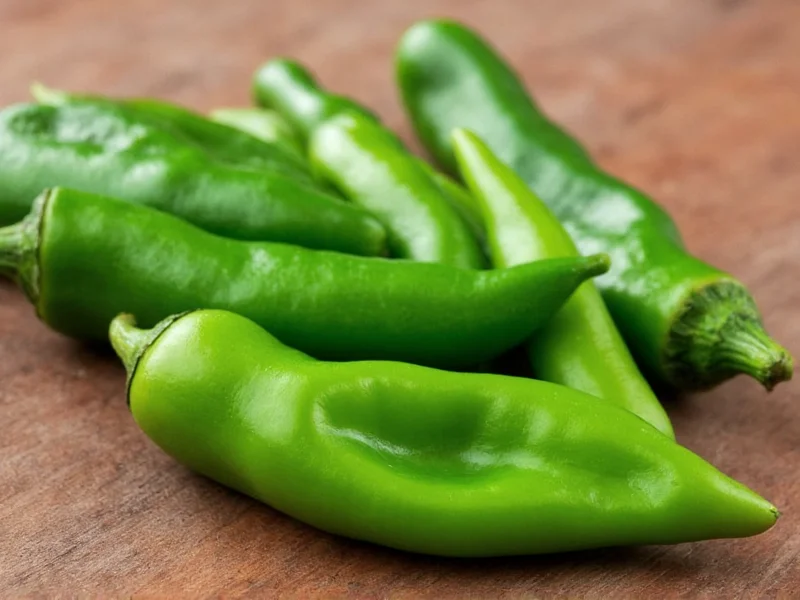Understanding the Heat Difference Between Serrano Chiles and Jalapeños
When comparing serrano chiles vs jalapeños, heat level represents the most significant difference. Serranos consistently rank hotter across the Scoville scale, typically registering two to three times the heat of jalapeños. This heat difference directly impacts how each pepper performs in various culinary applications.
The Scoville scale measurements tell the story clearly:
| Pepper Type | Scoville Heat Units (SHU) | Relative Heat Level |
|---|---|---|
| Serrano chiles | 10,000-23,000 | Moderate to Hot |
| Jalapeños | 2,500-8,000 | Mild to Moderate |
Physical Characteristics Comparison
Visually distinguishing serrano chiles from jalapeños requires attention to detail. Serranos typically measure 1-2.5 inches in length with a slender, tapered shape and smooth, thin skin. They grow upright on the plant rather than hanging down. When immature, they appear bright green, deepening to red, brown, orange, or yellow as they mature.
Jalapeños are noticeably larger, usually 2-3.5 inches long with a thicker, cylindrical shape and slightly wrinkled skin. They grow downward on the plant and follow a similar color progression from green to red as they ripen. The thicker walls of jalapeños make them particularly suitable for stuffing and pickling applications where serranos would become too soft.
Flavor Profiles and Culinary Applications
The flavor distinction between serrano chiles vs jalapeños significantly influences their culinary uses. Serranos deliver a clean, bright heat with grassy notes and minimal sweetness. This makes them ideal for fresh salsas, pico de gallo, and guacamole where their intense heat can shine without overwhelming other ingredients.
Jalapeños offer a more complex flavor profile with earthy, vegetal notes and subtle sweetness, especially when roasted. Their thicker flesh holds up well to cooking methods like grilling, roasting, and stuffing. Common applications include jalapeño poppers, pickled jalapeños, and as a key ingredient in chipotle peppers (smoked jalapeños).
Substitution Guide: When to Use Serrano Instead of Jalapeño
Understanding serrano chiles vs jalapeños substitution ratios prevents culinary disasters. Due to the significant heat difference, direct 1:1 substitution often results in unexpectedly spicy dishes. Consider these guidelines:
- For every 1 serrano pepper, use 2-3 jalapeños to achieve similar heat levels
- When substituting jalapeños for serranos, expect milder results with different flavor notes
- Remove seeds and membranes from either pepper to reduce heat intensity
- Serranos work better in fresh applications; jalapeños excel in cooked dishes
Growing Characteristics for Home Gardeners
Gardeners comparing serrano chiles vs jalapeños should note their different growing requirements. Serrano plants typically grow 24-36 inches tall with multiple upright-growing peppers. They require 70-80 days to maturity and prefer slightly warmer temperatures.
Jalapeño plants reach 24-30 inches in height with peppers that hang downward. They mature slightly faster at 65-75 days and demonstrate greater adaptability to varying climate conditions. Both varieties thrive in full sun with well-draining soil, but jalapeños generally prove more forgiving for beginner gardeners.
Nutritional Comparison
Both peppers offer impressive nutritional benefits with minor differences:
| Nutrient (per 100g) | Serrano Chiles | Jalapeños |
|---|---|---|
| Calories | 32 | 29 |
| Vitamin C | 141mg (235% DV) | 118mg (196% DV) |
| Vitamin A | 817IU | 1990IU |
| Dietary Fiber | 3.4g | 2.8g |
Both peppers contain capsaicin, the compound responsible for their heat, which has been linked to various health benefits including pain relief and metabolism boost. The higher capsaicin content in serranos means they deliver these benefits more intensely.
Storage and Preservation Techniques
Proper storage extends the shelf life of both peppers. Fresh serranos last 1-2 weeks in the refrigerator crisper drawer, while jalapeños maintain quality for 2-3 weeks due to their thicker walls. For longer preservation:
- Freezing: Both peppers freeze well for 6-8 months after washing and drying
- Pickling: Jalapeños are more commonly pickled, but serranos also work well
- Drying: Serranos dry effectively for use as dried chilies or powder
- Roasting: Jalapeños develop deeper flavors when roasted compared to serranos
Final Recommendations for Culinary Use
When deciding between serrano chiles vs jalapeños, consider your heat tolerance and recipe requirements. Choose serranos when you want intense, clean heat in fresh applications like salsas and guacamole. Opt for jalapeños when you need a more versatile pepper that holds up to cooking, stuffing, or pickling with a milder, earthier flavor profile.
Professional chefs often keep both varieties on hand to provide range in heat and flavor. Remember that heat levels can vary significantly within each pepper type based on growing conditions, so always taste a small piece before committing to a recipe.











 浙公网安备
33010002000092号
浙公网安备
33010002000092号 浙B2-20120091-4
浙B2-20120091-4